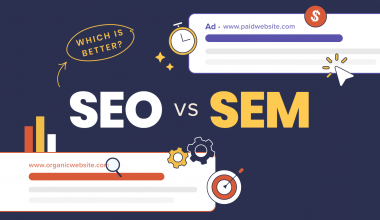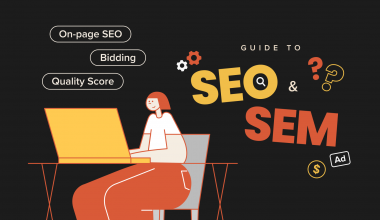Search Engine Marketing (SEM) is one of the most useful marketing tools that help brands garner visibility. However, the process that leads up to having your website sit unrivalled on the top of the results page involves several important steps. For someone who’s unfamiliar with the concept, it might seem like a daunting task to figure out, but this article will bring you through the simple steps, with a focus on improving quality score, to successfully adopting SEM for your brand!
Understanding SEM Basics
Before diving into the deep end of quality score, you’d first need to understand what SEM is and the process that’s involved. You’re probably more acquainted with SEM ads than you might’ve realized. Essentially, SEM is a marketing strategy that aids in boosting your content’s noticeability on search engines. As shown in the image above, content pushed through SEM is indicated with a little “Ad” in the upper left corner. Another name you might know SEM by is pay-per-click (PPC), as businesses will be charged a fixed amount for every time the custom ad is clicked.
This payment aspect is the main contrast between its counterpart, Search Engine Optimization (SEO), which is an organic method that’s reliant on refining content to include specific keywords and information that will elevate your website’s position on the results page.
However, just the payment alone does not guarantee your content a seat on the hot spot of the search engine results page. SEM involves a process called “Ad Auction” that entails 3 determinants: bid, quality score and expected impact.
The Ad Auction
Let’s say you want to engage with SEM for a particular piece of content from your business.
Research Keywords
The first thing you would have to do to enter the ad auction is to conduct research on keywords that are related to your business or topic. It would be a bonus for you if you researched and identified negative keywords as well, which would help to keep your content from showing up on searches made by users who aren’t in the right frame of mind to engage with your content.
Bidding Time!
From there, you would then have to make a bid with the sum that you’re willing to pay for every click on each of those keywords. The search engine you’re auctioning under would then evaluate if those specific keywords would fall within users’ search categories. If so, then your content would be submitted into the ad auction, where the virtual wrestling begins.
Quality Score
The second determinant and step of the ad auction process is arguably the most important one – the quality score. In this phase, your content/ad would be put through an assessment to determine how relevant it will be to a user in terms of click-through rate, keywords, landing page experience and past ad performance. If done well, a good result on the quality score might even put your ad in a better position than someone else who made a higher bid.
Ad Extensions
Finally, the ad extensions you include will be analyzed to help decide your ad’s overall standing. These ad extensions refer to the additional information that will be attached to the bottom of your ad when it appears on the results page, such as location, contacts, or even links. An estimate of the effectiveness and relevance of your ad’s performance will be made and would aid in procuring a better placement at a lower cost in the auction.
Key Factors of Quality Score
As previously mentioned, the quality score is of utmost importance when it comes to determining how your ad does in the auction. In fact, it has a direct connection to how successful your ad is on that particular search engine. Furthermore, a good quality score would enable you to “win” the ad auction. This would ultimately help in reducing your costs per click and giving you a higher return on investment (ROI). Here are some of the factors that you’ll need to keep an eye out for!
Expected Clickthrough Rate (CTR)
Clickthrough rate refers to the frequency of clicks you get on your ad when people come across it. Having a high CTR percentage would ultimately mean that your content has relevance amongst audiences. Aspects that make an ad clickable have to be taken into account, such as keywords, listings and platform. Hence, an estimate of your CTR would play a part in determining if your ad gets a favourable position in the auction or not.
Ad Relevance
As you’d already expect, an ad has to be relevant to its audiences (DUH!). One variable of that is through the use of related keywords throughout the ads. Essentially, this pertains to how well your ad can parallel a user’s search intent.
Landing Page Experience
How well-organized is your business’s landing page? Because it matters in the ad auction! An estimate will be made based on how original, useful and navigable your landing page might be to potential online visitors, in terms of visual and informational organization. It must be able to help audiences find what they are looking for in relation to the keywords that have been assigned to the ad.
SEM is a highly sought-after commodity in the digital advertising space. If done right, it may lead to increased engagement and revenue for your brand. These are some of the simple key factors that you’ll need to zhuzh up in order to gear your ads towards winning the ad auction!
Written by Clarice Low









